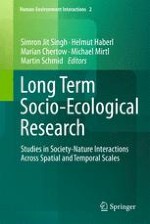2013 | OriginalPaper | Chapter
15. Global Socio-metabolic Transitions
Authors : Fridolin Krausmann, Ph.D., Marina Fischer-Kowalski, Ph.D.
Published in: Long Term Socio-Ecological Research
Publisher: Springer Netherlands
Activate our intelligent search to find suitable subject content or patents.
Select sections of text to find matching patents with Artificial Intelligence. powered by
Select sections of text to find additional relevant content using AI-assisted search. powered by
